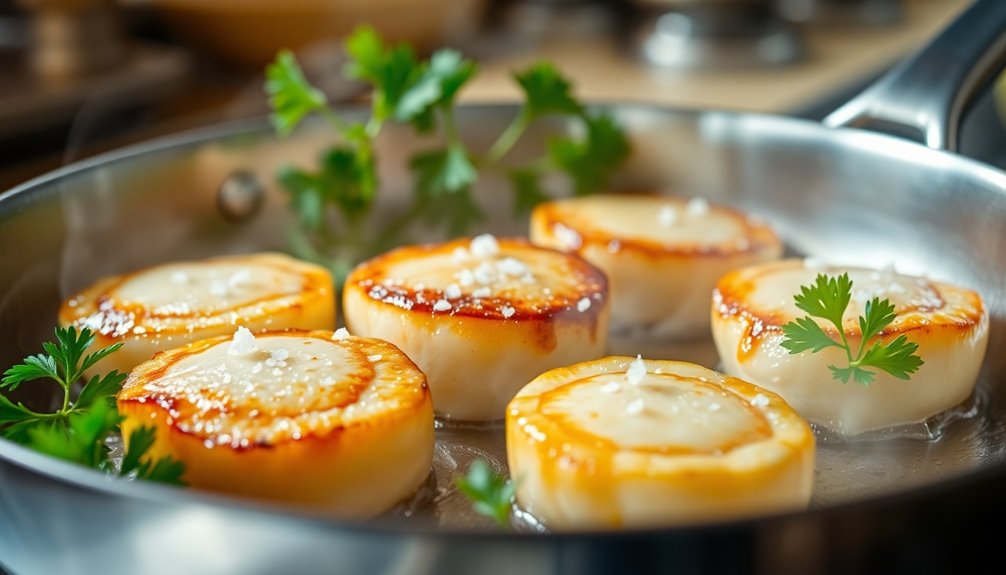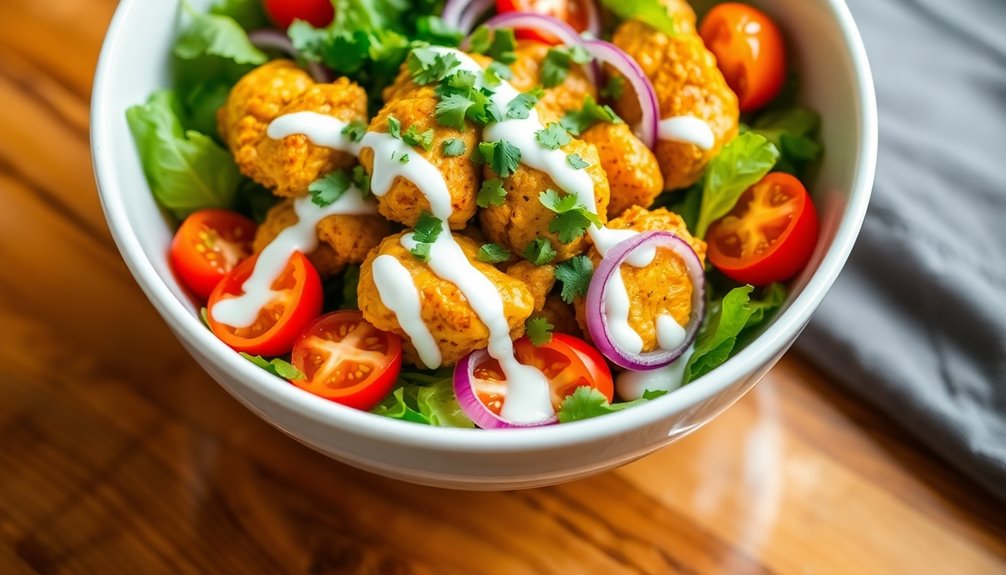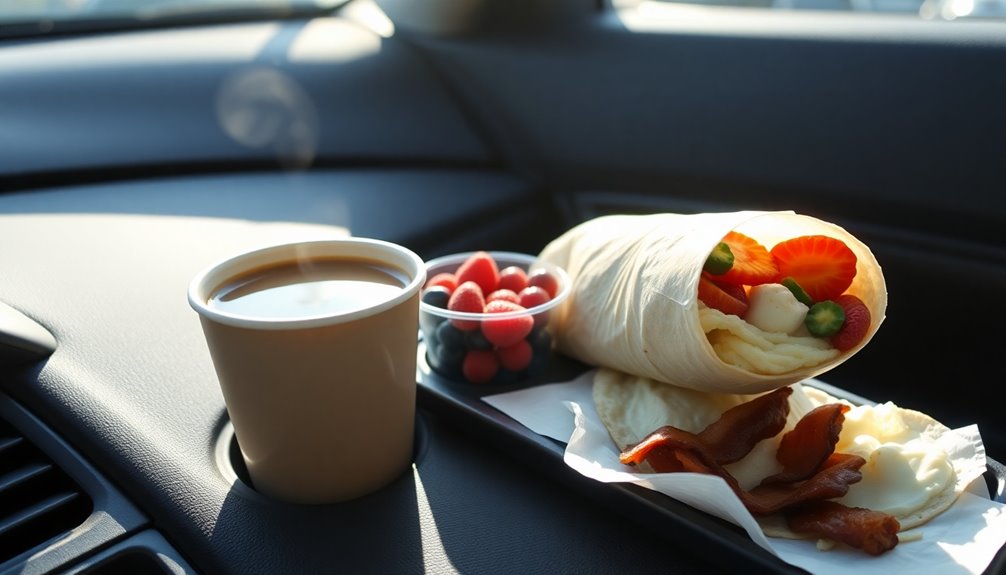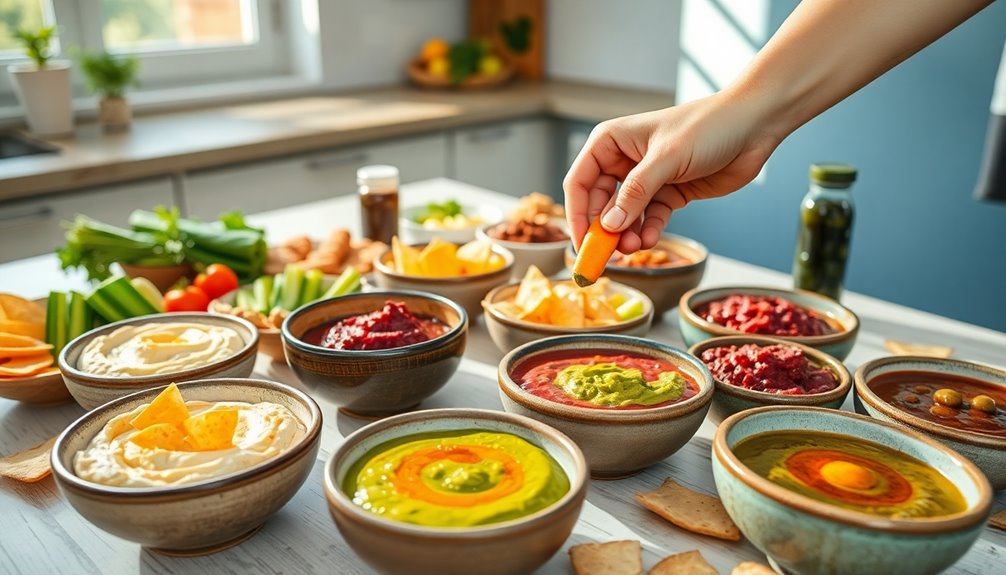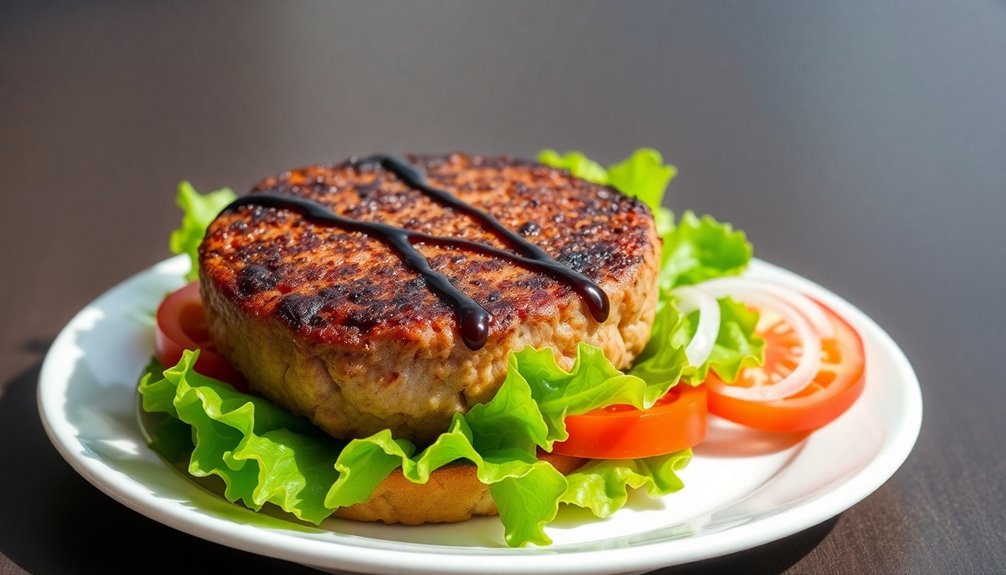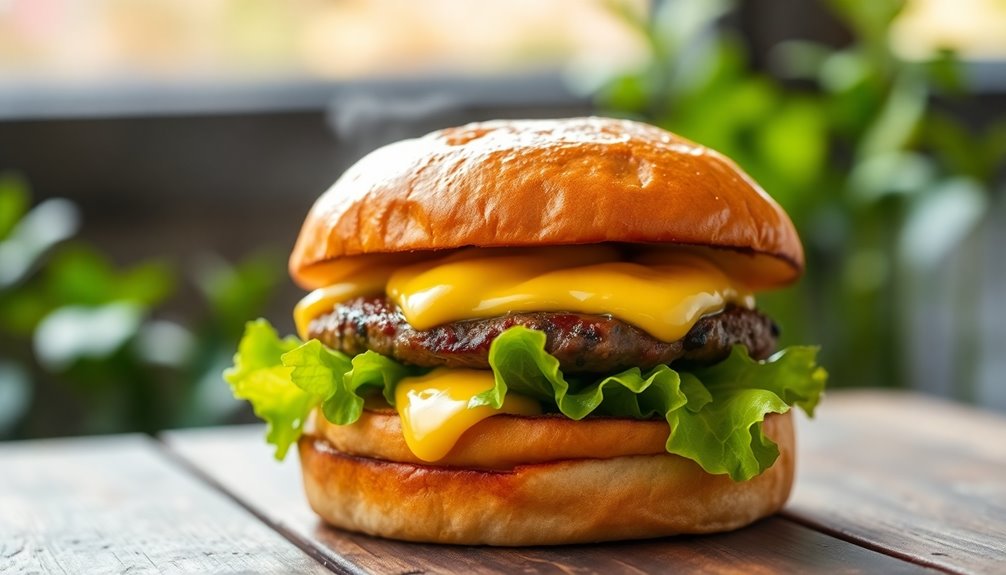Yes, you can fry scallops, and it's a fantastic way to enjoy their flavor and texture! To achieve that perfect golden-brown crust, heat oil to 400°F (200°C) and avoid overcrowding the pan. Fry them for just 3-4 minutes until they're crispy outside and tender within. For the best results, opt for large, dry-packed scallops from a trusted source. Using a cast iron skillet will help with even cooking. Pair them with creamy risotto or a fresh salad for a delightful meal. Curious about the best tips for choosing scallops or serving suggestions? Keep going for more insights!
Key Takeaways
- Frying scallops creates a crispy exterior while keeping the interior tender and juicy, enhancing overall flavor.
- Use large, dry-packed scallops for the best texture and taste, avoiding preservatives.
- Heat oil to 400°F (200°C) and avoid overcrowding the pan for even cooking.
- Fry scallops for 3-4 minutes until golden-brown, monitoring closely to prevent overcooking.
- Serve with complementary side dishes and garnishes to elevate the dining experience.
Benefits of Frying Scallops
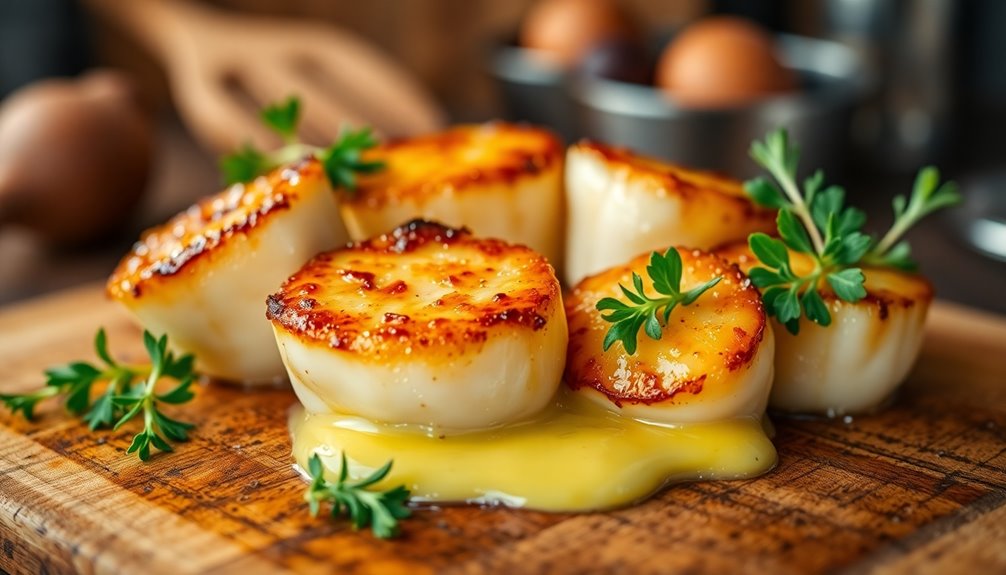
When you fry scallops, you're treated to a delightful contrast of textures: a crispy exterior that gives way to a tender, juicy interior. This cooking method enhances the natural flavor and texture of the scallops, making each bite a savory experience.
The frying process creates a delicious golden-brown crust through the Maillard reaction, which adds depth and complexity to their taste.
Using buttermilk and flour for breading before frying helps the coating adhere better, resulting in a more satisfying crunch. This method not only improves flavor but also elevates the overall eating experience.
Deep frying scallops guarantees even cooking, preventing any breading separation that can occur with skillet frying. This technique yields superior results, allowing you to enjoy perfectly cooked scallops every time.
Plus, frying scallops is efficient; you can have them ready in just 3-4 minutes, making it a quick option for a delicious seafood dish.
Incorporating frying scallops into your culinary repertoire opens up a world of flavor and texture, transforming a simple ingredient into a restaurant-quality meal you can enjoy at home.
Choosing the Right Scallops
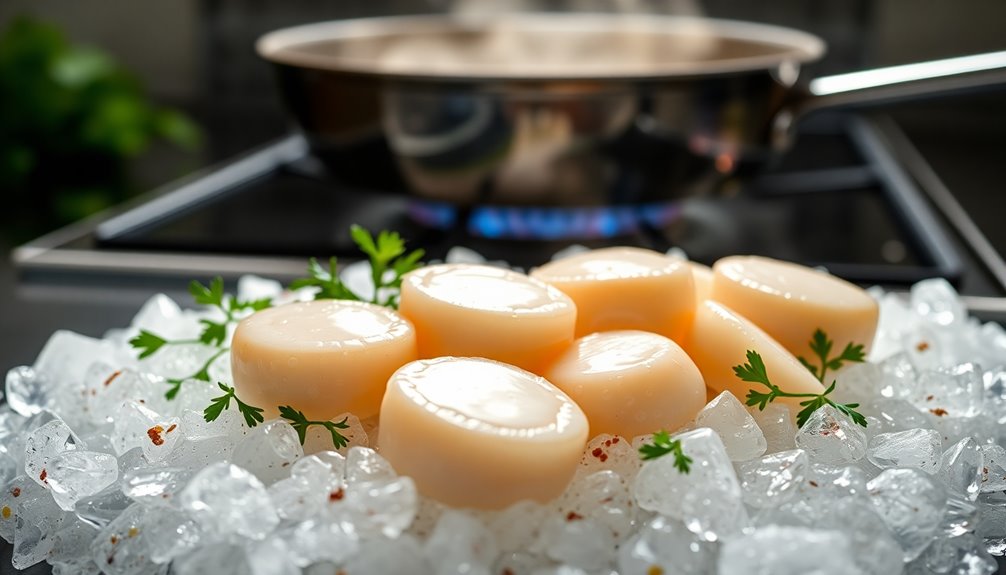
When you're picking scallops, go for large sea or diver scallops for the best flavor and texture.
Always choose dry-packed ones to avoid preservatives and guarantee a firmer bite.
Sourcing from trustworthy fishmongers will help you find the freshest options available.
Types of Scallops
Selecting the right scallops is vital for achieving the best flavor and texture in your dish. When considering the types of scallops, you'll want to focus on large dry sea scallops rather than smaller bay or Nantucket scallops. The larger sea scallops offer superior flavor and texture that can elevate your meal.
Among the options, diver scallops stand out as the highest quality due to their exceptional size and the sustainable fishing methods employed to harvest them.
It's important to look for scallops labeled as "dry-packed." These scallops don't contain the added preservatives found in "wet-packed" varieties, which can negatively impact the flavor and cooking performance. Aim for scallops classified as 10/20, meaning there are 10 to 20 scallops per pound—this size generally provides the best quality and taste.
Always remember to purchase your scallops from reputable sources to guarantee freshness. This will help you avoid any risk of spoilage and confirm that you're working with the best possible ingredients for your frying technique.
Sourcing Fresh Scallops
Finding the freshest scallops is key to enhancing your culinary creations. When sourcing scallops, make sure you choose large sea scallops over smaller bay or Nantucket varieties. Diver scallops, hand-harvested for superior size and quality, are your best bet. Always opt for dry-packed scallops instead of wet-packed, as they retain less moisture and offer a firmer texture when cooked.
Here's a quick reference guide to help you select the right scallops:
| Type | Characteristics | Size Indicator |
|---|---|---|
| Sea Scallops | Larger, better flavor and texture | 10/20 |
| Diver Scallops | Hand-harvested, high quality | 10/20 |
| Wet-Packed Scallops | Higher moisture, less firm | Avoid |
| Dry-Packed Scallops | Ideal for frying, firmer texture | 10/20 |
| Reputable Sources | Trusted fishmongers or seafood markets | Always choose |
Essential Cooking Equipment
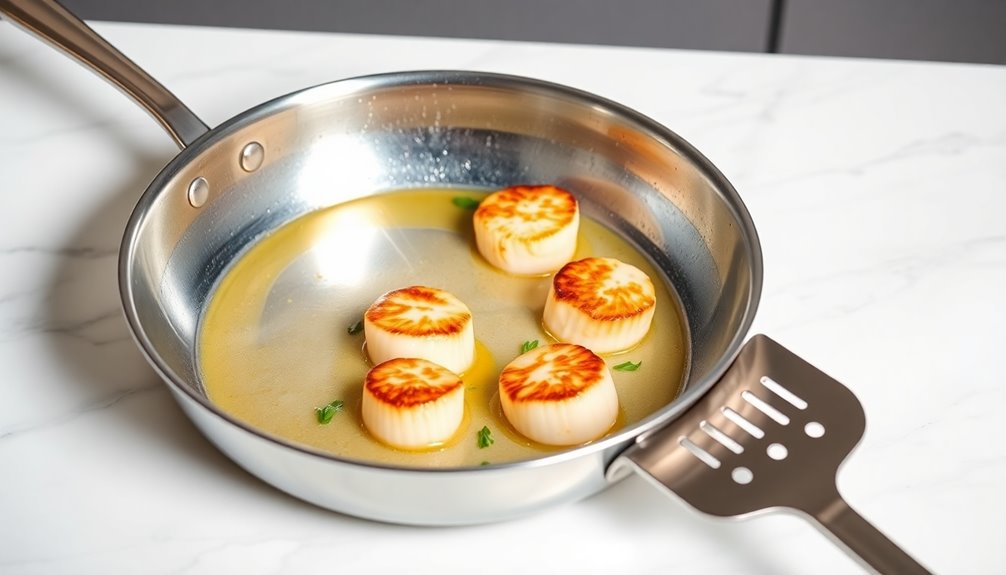
To achieve perfectly fried scallops, having the right cooking equipment is essential. A cast iron skillet is your best bet for this task. It retains high heat well, which promotes even browning and prevents sticking.
Before you start frying, make sure to preheat your skillet over medium-high heat. This step is vital for ensuring the scallops sear properly and develop that delicious crispy texture.
While a cast iron skillet is ideal, you can also use stainless steel or carbon steel pans. Both options provide good heat retention and the ability to achieve that perfect caramelization.
However, steer clear of non-stick pans; they won't allow for the proper browning and caramelization you need for perfectly fried scallops.
Always check that your skillet is thoroughly heated before placing the scallops in. This not only helps achieve a delicious crust but also enhances the overall flavor.
Step-by-Step Frying Instructions
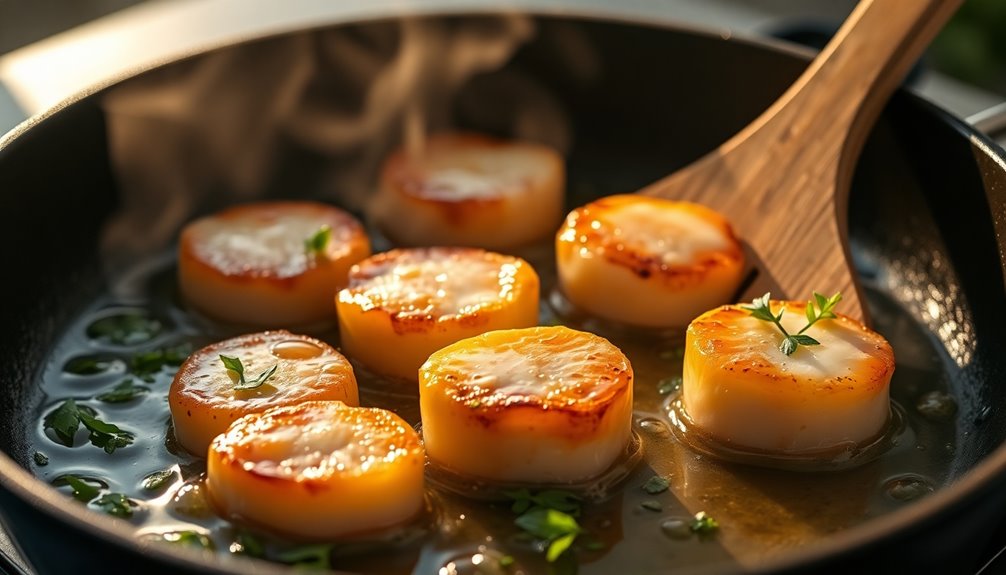
Now that you've got your skillet ready, it's time to master the frying process for scallops.
Begin by dipping each scallop in buttermilk, ensuring they're well-coated. Next, roll them in a mixture of flour, salt, and pepper to create a crispy exterior.
Heat your hot oil to 400°F (200°C) in a deep fryer or large saucepan. This temperature is essential for even cooking and achieving that perfect golden brown color.
Once the oil is hot, carefully place the scallops in the oil, frying them in batches. Avoid overcrowding to keep the oil temperature consistent, which helps in proper browning.
Cook the scallops for about 3-4 minutes, flipping them halfway through if needed. You'll know they're ready when they're golden and crispy.
After frying, take them out and let them drain on a paper towel-lined plate to remove excess oil, enhancing their crispiness.
For even better results, consider deep frying instead of skillet frying, as it helps the breading stick more effectively.
Follow these steps, and you'll have delicious, perfectly fried scallops ready to enjoy!
Serving Suggestions
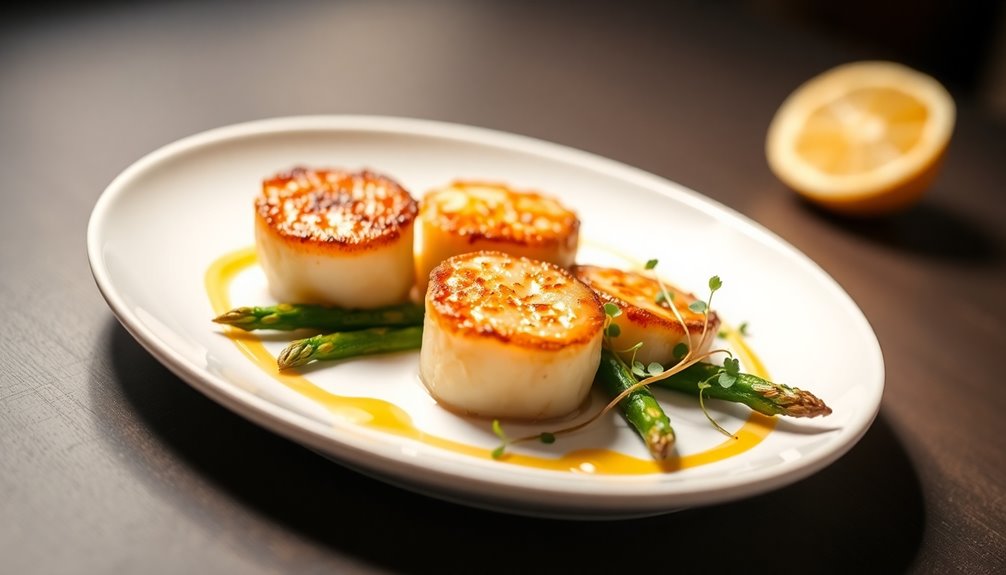
When it comes to serving fried scallops, pairing them with sides like creamy risotto or sautéed greens can elevate your meal.
Don't forget to garnish with fresh herbs to enhance presentation and add a burst of color.
These simple touches will make your dish not only delicious but visually appealing too.
Pairing With Side Dishes
Pairing scallops with the right side dishes can elevate your meal to new heights. Start by considering citrusy options, like a lemon and herb quinoa salad. This dish enhances the natural sweetness of scallops and brightens their flavor profiles.
A creamy risotto, especially one infused with parmesan or saffron, provides a rich contrast to the delicate texture of pan-seared scallops, creating a delightful balance on your plate.
For a nutritious touch, sautéed greens like spinach or kale can add vibrant color and earthy notes. They perfectly balance the richness of the scallops while contributing essential nutrients.
If you're in the mood for something heartier, roasted root vegetables such as carrots and parsnips offer satisfying texture and sweet undertones that harmonize beautifully with scallops.
Lastly, a light pasta dish, like linguine tossed with garlic, olive oil, and fresh herbs, rounds out your meal elegantly. Each of these options showcases the versatility of scallops and enhances your dining experience.
Garnishing for Presentation
Elevating the presentation of fried scallops can transform a simple dish into a stunning culinary masterpiece. When you're garnishing for presentation, think about how to enhance both the look and the flavor. Here are some tips to make your scallops shine:
- Use Fresh Herbs: A sprinkle of fresh parsley or chives adds color and flavor.
- Create a Flavor Bed: Serve your scallops on a bed of lemon-infused risotto or sautéed greens, adding elegance to your plate.
- Drizzle for Appeal: Finish with a little balsamic reduction or citrus vinaigrette to enhance both visual appeal and taste.
Don't forget to include thinly sliced lemon or lime wedges on the side. They not only brighten the dish but also allow diners to customize their experience.
For a sophisticated touch, consider plating your scallops alongside a small dollop of creamy sauce like garlic aioli or herb-infused butter. Remember, the Law of Attraction can also be applied to your culinary creations—visualizing a beautifully plated dish can inspire your presentation style.
When frying scallops, use high heat and a bit of olive oil for that perfect sear. If you need the best scallops per your recipe, ask your fishmonger for advice, ensuring you get the freshest quality possible!
Storing and Reheating Leftovers
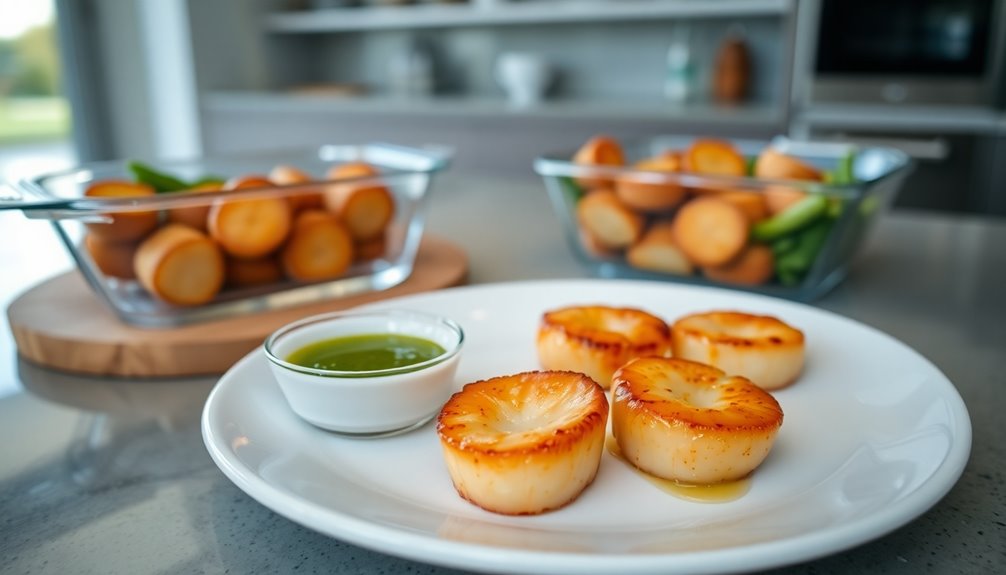
Leftover scallops can be a delightful treat if stored and reheated properly. To keep them fresh, place your scallops in an airtight container and store them in the refrigerator for up to 3 days. This will help prevent spoilage and maintain their flavor.
When you're ready to enjoy them again, you've got a couple of reheating options. If you're short on time, pop them in the microwave for about 30 seconds. Alternatively, use an air fryer for around 2 minutes to help retain that lovely texture.
Be careful not to overcook them! You only want to heat them until they're warm, not fully cooked again, or you'll end up with a rubbery texture. For the best results, avoid adding any liquids during reheating, as this can make your scallops soggy.
If you want to elevate the flavor a little bit, try squeezing fresh lemon juice over your reheated scallops. This simple addition can enhance their taste and make your leftovers feel like a fresh dish once again!
Enjoy your perfectly stored and reheated scallops!
Frequently Asked Questions
What Is the Best Cooking Method for Scallops?
When you're looking for the best cooking method for scallops, searing is your go-to technique. It creates a beautifully browned crust while keeping the inside tender and juicy.
Make sure your skillet's preheated to medium-high heat and use dry-packed scallops for ideal results.
Season them just before cooking, then sear for about 2 minutes on one side. Flip them, add butter and aromatics, and you'll have a delicious dish ready to enjoy!
Is It Better to Fry Scallops in Oil or Butter?
When deciding whether to fry scallops in oil or butter, consider the benefits of each.
Oil, like vegetable or canola, has a higher smoke point, making it ideal for searing.
Butter adds rich flavor but can burn quickly.
For the best of both worlds, use a blend of oil and clarified butter.
This way, you'll achieve a crispy crust while infusing those delicious buttery notes into your scallops.
Preheat your oil for perfect results!
How Long Should You Fry Scallops For?
Frying scallops is like a dance; timing is everything. You should fry them for about 3-4 minutes, turning them halfway through for even cooking.
Keep your oil at around 400°F (200°C) to get that perfect golden crust. Don't overcrowd the pan, or you'll risk a soggy mess.
Aim for a medium to medium-well doneness, where they're slightly translucent in the center. Monitor closely to avoid overcooking and ruin that delicious flavor!
What Not to Do When Cooking Scallops?
When cooking scallops, avoid using wet-packed ones, as they contain excess moisture that ruins the sear.
Don't overcrowd the pan; give each scallop space to develop a nice crust.
Skip seasoning too early; wait until just before cooking to keep them juicy.
Always use medium-high heat for the perfect golden-brown crust, and let them cook undisturbed for about two minutes before flipping to achieve that ideal sear.
Conclusion
Frying scallops is a delightful culinary adventure that brings out their sweet, briny essence and creates a golden, crispy edge. Picture those tender morsels sizzling in hot oil, their edges crisping to perfection while the aroma fills your kitchen. With the right technique, you're not just cooking; you're crafting a dish that's both elegant and comforting. So, grab your scallops, heat up that pan, and savor each bite of your delicious creation—you deserve it!
